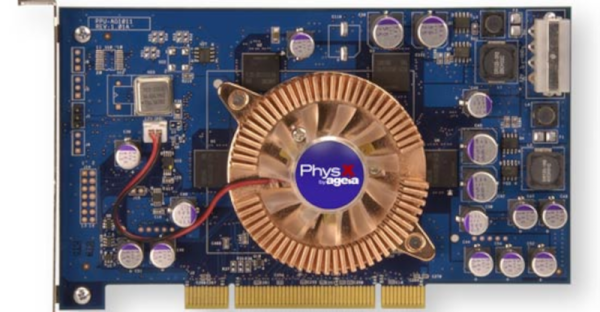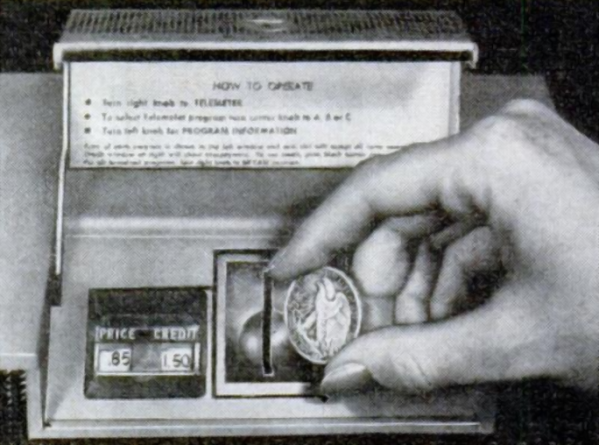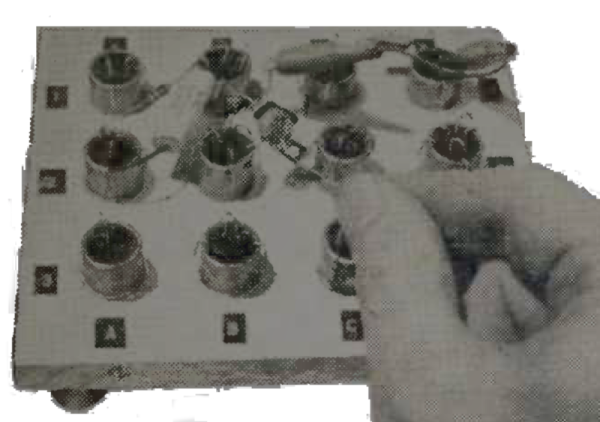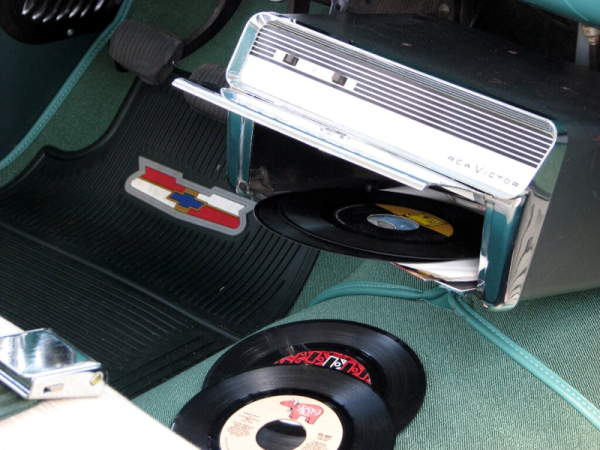Today, if you want to get a picture from your oscilloscope — maybe to send to a collaborator or to stick in a document or blog post — it is super easy. You can push an image to a USB stick or sometimes even just use the scope’s PC or web interface to save the picture directly to your computer. Of course, if it is on the computer, you could use normal screen capture software. But that hasn’t always been the case. Back in the days when scopes were heavy and expensive, if you wanted to capture an image from the tube, you took a picture. While you might be able to hold up your camera to the screen, they made specific cameras just for this purpose.
Archives
Retro Gadgets: Things Your TV No Longer Needs
It is hard to imagine that a handful of decades ago, TV wasn’t a thing. We’ve talked a few times about the birth of television. After an admittedly slow slow start, it took over like wildfire. Of course, anything that sells millions will spawn accessories. Some may be great. Then there are others.
We wanted to take a nostalgic look back at some of the strange add-ons people used to put on or in their TVs. Sure, VCRs, DVD players, and video game consoles were popular. But we were thinking a little more obscure than that.
Rabbit Ears
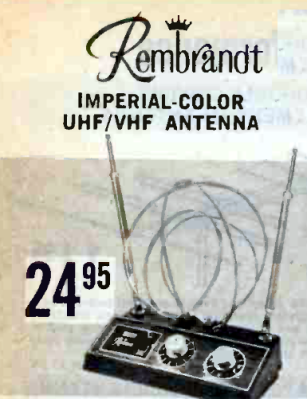
Every once in a while, we see an ad or a box in a store touting the ability to get great TV programming for free. Invariably, it is a USB device that lets you watch free streaming channels or it is an antenna. There was a time when nearly all TVs had “rabbit ears” — so called because they made an inverted V on the top of your set.
These dipoles were telescoping and you were supposed to adjust them to fit the TV station you were watching but everyone “knew” that you wanted them as long as possible at all times. Holding one end of them gave it a ground and would give you a major improvement in picture. People also liked to wrap tin foil around the tips. Was it like a capacitive hat? We aren’t sure.
The better rabbit ears had knobs and switches along with multiple elements. If you lived close to a TV station, you probably didn’t need much. If you didn’t, no number of fancy add-ons would likely help you. Continue reading “Retro Gadgets: Things Your TV No Longer Needs”
Retrogadgets: The Ageia PhysX Card
Old computers meant for big jobs often had an external unit to crunch data in specific ways. A computer doing weather prediction, for example, might have an SIMD (single instruction multiple data) vector unit that could multiply a bunch of numbers by a constant in one swoop. These days, there are many computers crunching physics equations so you can play your favorite high-end computer game. Instead of vector processors, we have video cards. These cards have many processing units that can execute “kernels” or small programs on large groups of data at once.
Awkward Years
However, there was that awkward in-between stage when personal computers needed fast physics simulation, but it wasn’t feasible to put array processing and video graphics on the same board. Around 2006, a company called Ageia produced the PhysX card, which promised to give PCs the ability to do sophisticated physics simulations without relying on a video card.
Keep in mind that when this was built, multi-core CPUs were an expensive oddity and games were struggling to manage everything they needed to with limited memory and compute resources. The PhysX card was a “PPU” or Physics Processor Unit and used the PCI bus. Like many companies, Ageia made the chips and expected other companies — notably Asus — to make the actual board you’d plug into your computer.
Retro Gadgets: Pay TV In The 1960s
These days, paying for TV programming is a fact of life. You pay your cable company or some streaming service and the only question is do you want Apple TV and Hulu or would you rather switch one out for NetFlix? But back in the 1960s, paying for TV seemed unthinkable and was quite controversial. Cable TV systems were rare, and the airwaves were a public resource, so allowing someone to charge to watch TV on the public airwaves was hard to imagine. That was the backdrop behind the Telemeter — an early attempt to monetize TV programming that was more like a pay phone than a modern streaming service.
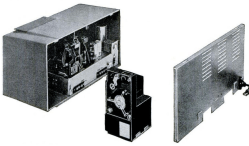
[Lothar Stern] wrote about the device in the November 1959 issue of Popular Mechanics (see page 220). The device looked like a radio that sat on top of your TV. It added a whopping three pay-TV channels, and inside was a coin box, and — no kidding — a tape punch or recorder. These three channels were carried from a Telemeter studio over what appears to be a dedicated cable strung on existing phone poles.
Of course, TVs with coin boxes were nothing new. But those TVs were found in public places, airports, and hotels. The money was simply to turn the TV on for a set amount of time. This was different. A set-top box unscrambled channels delivered over a dedicated cable. Seems like old hat today, but a revolutionary idea in 1959.
Retro Gadgets: The 1974 Breadboard Project
It is hard to imagine experimenting with electronics without the ubiquitous solderless breadboard. We are sure you have a few within arm’s reach. The little plastic wonders make it easy to throw together a circuit, try it, and then tear it down again. But, surprisingly, breadboards of that type haven’t always been around, and — for a while — they were also an expensive item. Maybe that’s what motivated [R. G. Cooper] to build Slip-n-Clip — his system for quickly building circuits that he published in a 1974 edition of the magazine Elementary Electronics.
The system isn’t really what you would think of as a breadboard today, but it was effective and certainly cheap to build. The biggest problem? It wasn’t something you’d use with DIP ICs. But in the early 1970s, you might not be building very much with ICs, and the ones you used might be in oddball transistor-like packages. Things were strange in the 70s!
A Brief History of Breadboards
In the very old days, people built radios and such on wooden substrates that were actually bread-cutting boards. That’s where the name came from. It was common to draw a diagram with the physical layout you had in mind, glue it to the board, and use it as a guide for building and troubleshooting. Wood was easy to drill and cut. A nail or a thumbtack would make dandy terminals. Probably the last time we saw that done was about a dozen years ago in Make Magazine. Even then, it was only a novelty — few people still build circuits like this, but you can see how [Colin] did it in the video below.
Continue reading “Retro Gadgets: The 1974 Breadboard Project”
Retro Gadgets: The Real Desktop Computer
People argue about the first use of the computer desktop metaphor. Apple claims it. Xerox probably started it. Yet, when I think of computer desktops, I think of the NOVAL 760. Not a household name, to be sure, but a big ad spread in a June 1977 Byte magazine was proud to introduce it. At $2995, we doubt many were sold, but the selling point was… well… it was built into a “handsome wood desk, designed to compliment any decor.” The desk folded down when you were not using the computer, and the keyboard recessed into a drawer.
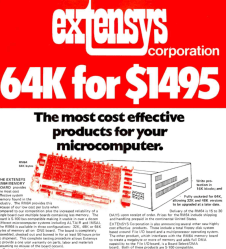 The computer itself was no slouch for 1977, but nothing you couldn’t find elsewhere. An 8080, speed unspecified, had 16 kB of RAM and 3 kB of PROM. There was also a display with a few kB of memory hanging around, too. And just in case you were worried, the bottom of the page entitled “The Ultimate in Home Computers” reads, “The NOVAL 760 COMPUTER. A fully-assembled, fully-tested personal computer … not a kit!” Of course, for us, that’s not really a selling point. If you wonder why the computer was memory limited, this is the time that Extensys bragged in an ad: 64 kB for $1495! If you ordered one, you could have it in 15 to 30 days, too!
The computer itself was no slouch for 1977, but nothing you couldn’t find elsewhere. An 8080, speed unspecified, had 16 kB of RAM and 3 kB of PROM. There was also a display with a few kB of memory hanging around, too. And just in case you were worried, the bottom of the page entitled “The Ultimate in Home Computers” reads, “The NOVAL 760 COMPUTER. A fully-assembled, fully-tested personal computer … not a kit!” Of course, for us, that’s not really a selling point. If you wonder why the computer was memory limited, this is the time that Extensys bragged in an ad: 64 kB for $1495! If you ordered one, you could have it in 15 to 30 days, too!
There were options for more memory, and it wasn’t clear how many of the I/O devices in the ad were actually included in the advertised price. Some of the devices seemed very specialized, so we are guessing the basic system didn’t include some of them.
Retro Gadgets: I Swear Officer, I Was Listening To 45
Audio in cars has a long history. Car radios in the 1920s were bulky and expensive. In the 1930s, there was the Motorola radio. They were still expensive — a $540 car with a $130 radio — but much more compact and usable. There were also 8-tracks, cassettes, CDs, and lately digital audio on storage media or streamed over the phone network. There were also record players. For a brief period between 1955 and 1961, you could get a car with a record player. As you might expect, though, they weren’t just any record players. After all, the first thing to break on a car from that era was the mechanical clock. Record players would need to be rugged to work and continue to work in a moving vehicle. As you might also expect, it didn’t work out very well.
It all started with Peter Goldmark, the head of CBS Laboratories. He knew a lot about record players and had been behind the LP — microgroove records that played for 22 minutes on a side at 33.3 RPM instead of 5 minutes on a side at 78 RPM. He knew that a car record player needed to be smaller and shock-resistant. Of course, in those days, it would have tubes, but that could hardly be helped.
The problem turned into one of size. A standard 10- or 12-inch disk is too big to easily fit in the car. A 45 RPM record would be more manageable, but who wants to change the record every three or four minutes while driving?
Continue reading “Retro Gadgets: I Swear Officer, I Was Listening To 45”



